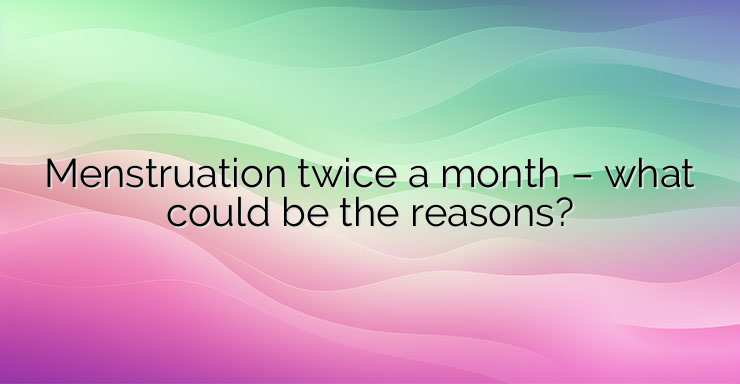The average length of a menstrual cycle is 28 days, but it can vary from 24 to 38 days. In women whose periods are shorter, the menstrual cycle may occur more than once a month. Although random changes in your menstrual cycle are not unusual, frequently seeing two periods a month may indicate the presence of an underlying health problem. Possible causes of menstrual cycle changes include: Single case Sometimes women may have a shorter menstrual cycle that includes two periods per month. Their periods may then return to their usual length. This random change is why doctors look for consistent patterns of frequent bleeding before making a diagnosis or offering treatment, unless an infection or more serious problem is present. Young age Irregular menstrual cycles are common in young women. They may have a shorter or sometimes longer menstrual cycle during puberty. Hormone levels vary greatly during this period of development. Research shows that in young women, menstrual cycle regulation can take about 6 years, from the time of menarche. Endometriosis Endometriosis is a condition in which tissue similar to the uterus grows in other parts of the body. Endometriosis can cause abdominal pain, unusual cramping, and irregular bleeding. Sometimes the bleeding can be heavy enough to look like another period. In some circumstances, doctors can diagnose endometriosis through a pelvic exam and ultrasound. However, laparoscopy is the only definitive method for diagnosing the disease. Perimenopause Perimenopause refers to the years leading up to menopause when the hormone levels in a woman’s body begin to change. Perimenopause can last up to 10 years. During this time, women often report irregular periods, including shorter or longer periods, missed periods, or heavier or lighter bleeding. Problems with the thyroid gland The thyroid gland is a regulator of hormonal processes in the body. Irregular menstrual cycles are a common symptom associated with thyroid problems. This is seen in both underactive thyroid, or hypothyroidism, and overactive thyroid, or hyperthyroidism. According to the World Health Organization, approximately one in eight women will experience thyroid problems in their lifetime. Uterine Fibroids Uterine fibroids are growths that occur in the uterus. Fibroids are usually not cancerous, but they can cause bleeding, especially heavy bleeding during the menstrual cycle. Additional symptoms of fibroids may include a feeling of fullness or pressure in the pelvis, frequent urination, lower back pain, pain during sex. Although it is not completely known what causes the development of uterine fibroids, it is known thatthat they tend to develop in families with a history of benign uterine growths, and changes in hormone levels can affect them. References: 1. Bleeding disorders in women. (2017, December 11) https://www.cdc.gov/features/bleedingdisorder/index.html 2. Endometriosis. (2018, March 16) https://www.womenshealth.gov/az-topics/endometriosis 3. Perimenopausal bleeding and bleeding after menopause. (2011, May) https://www.acog.org/Patients/FAQs/Perimenopausal-Bleeding-and-Bleeding-After-Menopause 4. Wise, LA, Mikkelsen, EM, Rothman, KJ, Riis, AH, Sørensen, HT, Huybrechts, KF, … Hatch, EE (2011, September 15). A prospective cohort study of menstrual characteristics and time to pregnancy. American Journal of Epidemiology, 174(6), 701–709; https://academic.oup.com/aje/article/174/6/701/88882


Leave a Reply